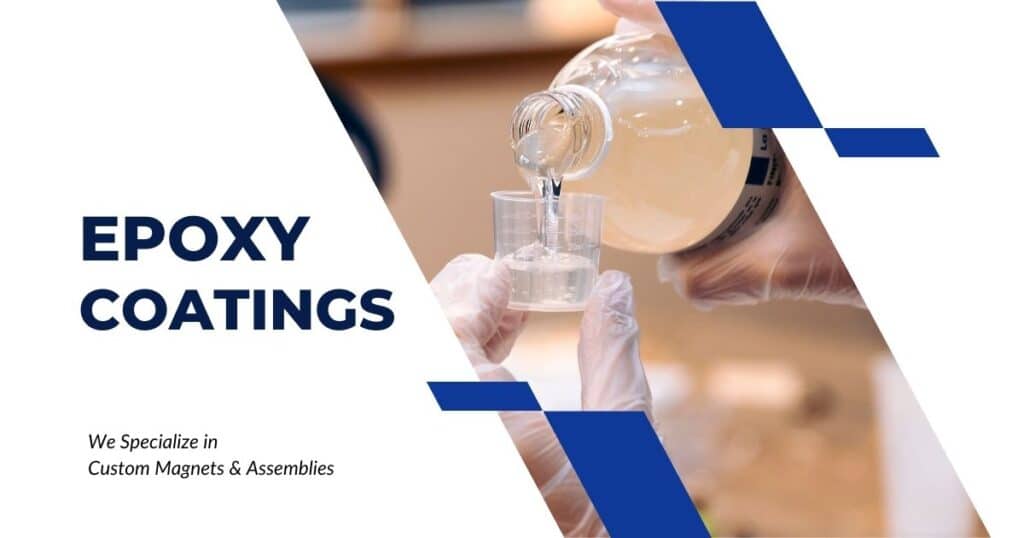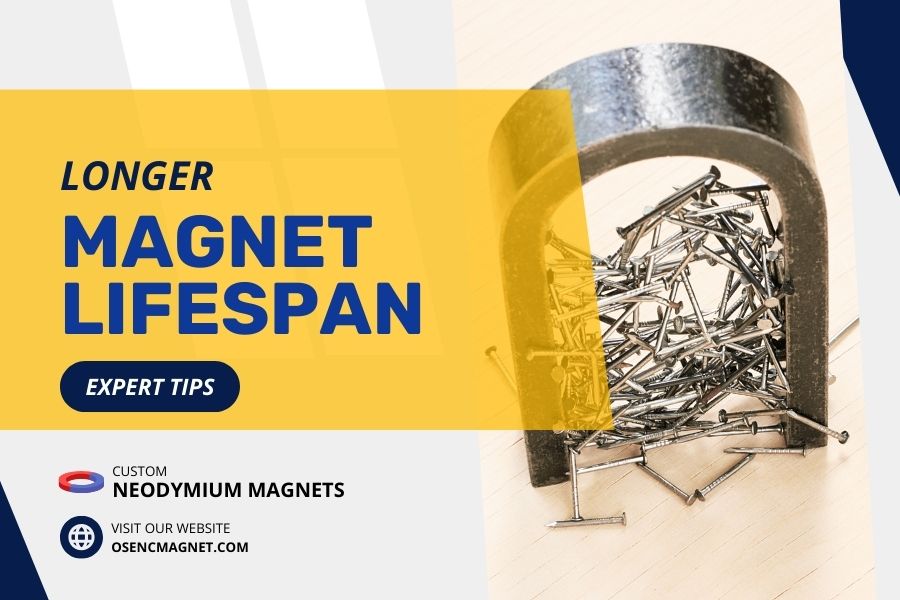Need your powerful neodymium magnets to last?
The right coating makes all the difference.
In this guide, you’ll discover:
- How epoxy coatings shield against rust, chemicals, and physical damage
- The different types of epoxy coatings manufacturers use
- When to choose epoxy and when to look at alternatives
- Real-world applications where epoxy-coated magnets excel
- Practical tips for selecting the best coating for your specific project
Whether you’re using magnets in wet environments, industrial settings, or precision applications, this guide will help you make smarter choices to extend your magnets’ lifespan and performance.
Let’s dive in.
Table of Contents
Why Neodymium Magnets Need Protection
Neodymium magnets pack incredible strength into small packages.
But these powerful tools have a weakness.
- They contain iron and rare earth elements that quickly react with oxygen and moisture.
- Leave them exposed, and they’ll rust and corrode.
- Almost every NdFeB magnet you buy needs a protective coating just microns thick.
- Without it, neodymium oxidizes when exposed to air and moisture, and your magnet weakens fast.
Sintered neodymium magnets have tiny pores throughout.
These microscopic holes let moisture seep in and speed up corrosion.
And it’s not just chemical damage you need to worry about.
These magnets are hard but break easily.
Without protection, they chip and crack, especially at the edges and corners.
What Makes Epoxy the Right Choice
The Science Behind Epoxy Protection
Epoxy is a two-part polymer. It mixes resin (usually Bisphenol A or F) with a curing agent (often amine or anhydride). When these parts combine, they create a crosslinked reaction.
The result? A tough, chemically resistant material that sticks well to metal.
When coated on a magnet, epoxy seals the metal surface from water and air. This stops rust and oxidation that would otherwise damage your magnet. The coating fights corrosion and adds some protection against impacts and scratches.
- Epoxy coatings are thin—just 10-25 micrometers per side.
This thin but complete coverage protects your magnet without making it bulky or weaker.
Key Benefits of Epoxy Coatings
A good epoxy coating gives you several advantages:
Corrosion Resistance
Cured epoxy blocks water and oxygen. This directly stops the metal from oxidizing. Epoxy-coated magnets can survive 72+ hours in salt spray tests without rusting.
Electrical Insulation
Epoxy insulates electricity. This helps when you don’t want electrical contact with the magnet surface. In motors or generators, it prevents unwanted currents and short-circuits.
Strong Adhesion
Epoxy sticks well to properly prepared surfaces. This creates an even protective layer around your magnet.
Chemical Resistance
Good epoxy fights off more than just water. It stands up to weak acids, mild alkalies, and salt. This makes epoxy-coated magnets perfect for mildly corrosive industrial settings.
Mechanical Cushioning
The polymer nature of epoxy absorbs some impact energy. Drop or knock a magnet, and the epoxy coating might save it from shattering.
Types of Epoxy Coatings for Neodymium Magnets
Manufacturers use several types of epoxy coatings on neodymium magnets:
Cathodic Epoxy Dip Coating (KTL)
They dip magnets in an epoxy bath and use an electric field to deposit an even layer on all surfaces.
This creates uniform coverage even on complex shapes. KTL coatings work great in damp and mildly acidic or alkaline environments.
Epoxy over Nickel Plating (Duplex Coating)
Many “epoxy-coated” magnets actually wear multiple layers.
A nickel base layer provides hardness and grip, while the outer epoxy (usually black) adds more rust protection and electrical insulation.
Spray or Brush Epoxy Coatings
Sometimes they spray or brush epoxy resin directly onto magnets.
This works for prototypes or special projects. The surface needs proper cleaning and maybe priming for the epoxy to stick well.
Colored Epoxy and Urethane Hybrids
While black is most common, you can find gray or white coatings too.
Some makers use special formulas like epoxy-urethane blends for better strength or looks.
How Manufacturers Apply Epoxy Coatings
Putting epoxy on magnets takes careful prep and skilled application.
Surface Preparation is Critical
Before coating, manufacturers need to:
- Clean off oils, grease, and dirt for good bonding
- Sometimes roughen the surface with media blasting or mechanical scrubbing
- Occasionally add chemical treatments like phosphating before applying epoxy
Common Application Methods
Dip Coating
They dunk magnets in epoxy solution, pull them out slowly, and let them drain. This simple approach works well for coating lots of magnets at once.
Spray Coating
They spray epoxy mix onto the magnet to create a thin, even layer. This method ensures consistent thickness, even on complex shapes.
Powder Coating
They electrostatically charge dry epoxy powder and spray it onto grounded magnets. The coated magnets then bake in an oven for a uniform, tough finish.
Finding the Balance: Thickness and Curing
Most epoxy coatings range from 10 to 30 micrometers thick. Thicker coatings protect better but can slightly weaken the magnet’s surface strength by increasing distance.
The thickness choice involves trade-offs.
- Thin coatings offer less protection and cushioning.
- Too-thick coatings might mess up precise dimensions for exact applications.
Getting the curing process right is also important:
- Standard epoxy typically cures at 150-200°C for 10-30 minutes
- Some two-part systems cure at room temperature over hours or days
- Heat-sensitive magnets need careful temperature control during curing to prevent demagnetization
- Manufacturers often magnetize magnets after high-temperature coating processes
Key Quality Parameters for Epoxy Coatings
When checking epoxy coatings for neodymium magnets, look for these quality factors:
- Coating Thickness: A good thickness (15-25 µm) ensures full coverage, especially on edges and corners. Even thickness gives uniform protection.
- Adhesion to Substrate: Good adhesion means the epoxy sticks tightly to the magnet and won’t peel off. Proper surface prep and correct curing make this happen.
- Corrosion Resistance: Quality epoxy-coated magnets should last at least 48-72 hours in salt spray tests without showing rust.
- Chemical Resistance: The coating should fight off chemicals it might meet. Good epoxy stands up to water, saltwater, oils, and many mild acids or bases.
- Mechanical Durability: Quality epoxy should be hard enough to resist scratches but tough enough not to crack.
- Thermal Tolerance: The coating should work well across expected temperatures, usually staying stable up to 120-150°C.
- Uniform Coverage: Even coverage on all surfaces, including corners and edges, is vital. Pinholes or bubbles are flaws that weaken protection.
How Epoxy Compares to Other Coatings
When protecting your neodymium magnets, consider these alternatives:
Nickel-Copper-Nickel (NiCuNi)
This standard plating gives moderate rust resistance and a harder surface than epoxy.
But it can develop tiny holes or micro-cracks that let corrosion sneak in underneath.
NiCuNi serves as the standard plating for most neodymium magnets.
Zinc Plating
A cheaper option that’s common but less rust-resistant than epoxy or NiCuNi.
Zinc usually needs an extra sealant for proper protection.
It works fine for non-demanding settings.
Polyurethane
These coatings flex well but often can’t match good epoxies in chemical and scratch resistance.
Epoxy generally sticks better and resists chemicals better than many other organic coatings.
Phosphate Conversion Coating
Sometimes used as a primer or where magnets won’t face harsh conditions.
This rarely works as a standalone solution for tough environments.
Parylene Coating
For uses needing ultra-thin coatings (5-10 μm), parylene protects with less thickness than standard epoxy.
It’s used in precision applications where every micron counts.
Potential Concerns with Epoxy Coatings
Even the best protection has its limits:
Scratches Easily
Epoxy scratches more easily than metal coatings like nickel.
In rough settings with abrasion, epoxy wears away faster than metal plating.
Sharp objects can gouge the epoxy, and since it’s thin, even small scratches might expose the metal underneath.
Breaks Under Impact
Hit it hard enough, and the epoxy layer cracks or chips off.
Manufacturers admit epoxy layers “can crack under significant impacts.”
Drop an epoxy-coated magnet on a hard floor, and you might see spiderweb cracks in the coating, especially at edges.
Can’t Handle High Heat
Standard epoxy starts breaking down around 120-150°C.
Long exposure to high heat makes the coating lose grip or break down.
Too much heat (around 150°C and above) hurts both the epoxy coating and the magnet’s performance.
Degrades in Sunlight
Long exposure to sun makes epoxy yellow, chalk, or grow brittle over time.
For outdoor use in direct sun, you may need UV-stabilizers or an opaque topcoat.
Expands Differently Than the Magnet
If epoxy expands at a different rate than the magnet when heated, repeated heating/cooling cycles can cause tiny cracks or peeling.
Hard to Coat Edges
Edges and corners are tough to coat evenly.
Poor coverage or “bubbling” at these points can expose bare metal, creating rust risks.
Hard to Repair
If damaged, you can’t easily touch up epoxy coatings.
Often the magnet needs complete recoating by the manufacturer.
If moisture gets under a cracked layer, rust can spread unseen beneath the coating.
Costs More
Epoxy coating usually costs a bit more than standard nickel plating because of extra processing steps.
Best Applications for Epoxy-Coated Magnets
Epoxy-coated neodymium magnets work great in these settings:
- Humid or Marine Environments: They fight rust even in harsh, wet, salty conditions. You’ll find them in offshore wind turbines, tidal power generators, and marine equipment.
- Chemical and Industrial Settings: In factories where magnets touch oils, cleaners, or mild chemicals, epoxy creates a strong barrier. They work well in chemical processing plants and lab equipment.
- Outdoor and Weather-Exposed Uses: Door latches, gate closures, outdoor sensors, and signs all benefit from epoxy coating. The epoxy basically “weatherproofs” the magnet.
- Electrically Sensitive Applications: Electric motors, generators, transformers, and magnetic couplings often need epoxy-coated magnets to avoid conductive coatings that might create unwanted electrical currents.
- Magnet Assemblies and Bonded Systems: When magnets get assembled with adhesives or over-molding, epoxy coatings shine. They give glues a good surface to grip.
- Biomedical and Food Industry Uses: For magnets in medical devices, lab instruments, or food processing, the inert, easy-to-clean epoxy surface works great.
When to Avoid Epoxy Coatings
Skip epoxy coatings in these situations:
High Abrasion Environments
If your magnet will slide against other surfaces often, epoxy wears through quickly.
A magnetic base you move frequently on concrete or metal will soon scrape away the epoxy.
Better options?
Hard nickel plating or stainless steel cases.
Heavy Impact Settings
When magnets take strong hits or vibration, epoxy coatings crack.
Magnetic couplings in heavy machinery or tools that might get dropped aren’t good for epoxy.
If an epoxy-coated magnet chips, the broken pieces could contaminate nearby machinery.
Hot Environments
Temperatures above 150°C break down standard epoxy coatings.
Car engine compartments, industrial ovens, or high-performance motors get too hot for epoxy.
Look instead at high-temp coatings like parylene HT or certain ceramics.
Constant Sunlight
For magnets in direct sun daily (like solar trackers or outdoor sensors), UV light damages epoxy over time.
Try epoxy with UV inhibitors, a UV-resistant topcoat, or PTFE (Teflon) which handles sun exposure well.
Harsh Chemicals
While epoxy resists mild chemicals, it fails against very corrosive solutions or strong solvents.
In plating baths with strong acids or cleaning with acetone, epoxy can swell, soften, or dissolve.
Vacuum or Cleanroom Settings
Epoxy releases gases in high vacuum, which can deposit on optics or sensors in vacuum chambers or satellites.
Cleanrooms often avoid epoxy if any particle shedding is a problem.
Precision Applications
For high-precision magnetic assemblies where every micron counts, epoxy’s typical thickness might be too much.
Look at ultra-thin options like parylene (5-10 μm) for these precision needs.
Making the Right Choice for Your Project
Epoxy coatings protect neodymium magnets well in many uses.
They block rust, handle impacts better, and make your magnets last longer.
For best results, ask yourself:
- Where will you use them? Will they face moisture, chemicals, or impacts?
- How exact must your measurements be?
- Will they get hot? How hot?
- What kind of epoxy does the coating use? Is it right for your needs?
- Has the manufacturer tested the coating for sticking power and rust resistance?
When picking an epoxy coating, also think about:
Working Conditions
Match the coating to your challenges.
Epoxy handles moisture and chemicals well but struggles with extreme heat or scratches.
Good epoxy-coated magnets should last at least 48-72 hours in salt spray tests without rusting.
How Long You Need Them
For decades of use in tough settings, you might need high-quality coatings with multiple layers.
For critical applications, try epoxy over nickel (black epoxy coating) for best protection.
Physical Stresses
Think about how you’ll mount and use the magnet.
Installation can damage the coating if you’re not careful.
If using glue, epoxy-coated magnets perform better in glue shear-off tests than some other coatings.
Coating Quality
Not all epoxy coatings are the same.
Ask suppliers what options they offer and what standards they meet.
For marine or outdoor use, ask specifically about “marine-grade” epoxy with extra protection.
Size Concerns
Epoxy adds about 0.02mm to each surface.
Account for this in your design if exact dimensions matter.
Pay special attention to edges and corners, which often get thinner coating.
Colors Available
While black is most common, epoxy coatings come in other colors like gray or white for specific needs.
White epoxy coatings work well for medical or aesthetic applications.
Quality epoxy coatings can vastly extend how long your neodymium magnets last.
Understanding these points helps you make smart choices for your project.
Need Epoxy Coated Magnets?
Contact our team today to discuss custom neodymium magnet solutions with the perfect protective coating for your needs.



